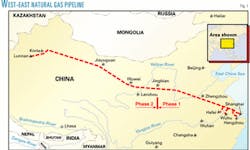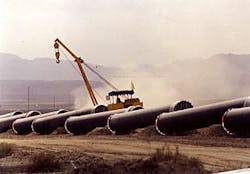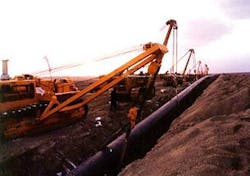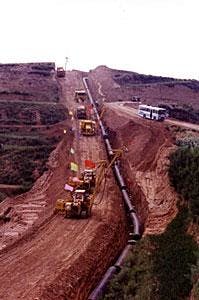Construction of major Chinese gas pipeline enters final phase in 2003
Construction began late last year on PetroChina Co. Ltd.'s West-to-East natural gas pipeline project and targets 2004 for completion of the nearly 3,800 km (2,360 mile), 1,016-mm (40-in.) mainline and 294 km of 813 mm, 508 mm, and 406 mm lateral lines.
Fuel growth; reduce pollution
The project was conceived to transport the significant natural gas reserves from the Tarim basin in Xinjiang Autonomous Region in far western China to markets in eastern China near the cities of Zhengzhou and Nanjing with the mainline terminating in Shanghai and lateral pipelines terminating in Hangzhou, Wuhu, and Hefei (Fig. 1).
The natural gas is needed to fuel China's significant economic growth as well as to provide clean energy to reduce pollution from coal use in major population centers of eastern China.
Project construction covers two phases (Fig. 1).
The first consists of about 1,856 km of 1,016 mm line pipe and will access existing natural gas production from Changqing oilfield near Jingbian in Shanxi Province to flow to Shanghai at yearend 2003.
The second phase consists of about 1,962 km of 1,016 mm line pipe and will connect natural gas production in the Tarim basin near Lunnan in Xinjiang Autonomous Region to the western end of the mainline completed in Phase 1 in Jingbian by yearend 2004.
Construction, supervision
Universal ENSCO Inc., Houston, performed a feasibility study and was awarded the foreign construction supervision contract by PetroChina for the project.
The feasibility study was completed in summer 2001, and the foreign construction supervision was initiated in August 2001.
Line pipe (40-in. OD) strung along the right-of-way in western China awaits welding and installation crews on this segment of PetroChina Co. Ltd.'s West-East natural gas pipeline.
null
PetroChina designed a construction supervision model consisting of a foreign firm working in partnership with a Chinese construction supervision firm to supervise the pipeline's construction. Universal has been working with Longway Construction Supervision Co., Langfang, Hubei Province, on the overall supervision of the project from a headquarters office in Beijing and project site offices in Kuerle, Linfen, Zhengzhou, Nanjing, and at the Yangtze River crossing. An additional project site office in Wuwei will be operational for 2003.
null
Mainline construction faces some of the most formidable challenges of any pipeline project. The line is the first large-diameter pipeline project ever constructed in China. Additionally, it is the first to use automatic welding and automatic ultrasonic inspection on pipeline in China.
Preparing domestic contractors, including acquisition of equipment and labor resources, to construct this massive project with no previous experience on large-diameter pipe or automatic welding was a significant challenge alone. The massive challenge of building the mainline is evident when one considers that it:
- Traverses the edge of the Gobi Desert.
- Crosses three mountain ranges with tunnels through 16 mountains.
- Has 16 aerial crossings.
- Crosses the rugged and highly erodible Loess Plateau.
- Crosses the Yellow River three times (installation methods including a tunnel, pipe jacking, and aerial crossing).
- Crosses the Yangtze River once (a 4.4-m diameter concrete lined tunnel).
- Crosses 39 other rivers and areas by horizontal directional drill.
- Crosses "waternet" (areas of irrigation canals and ditches with intensive farming of rice and ponds for raising fish).
Is semi-urban and urban construction for almost the entire last 300 km.
Includes installation of about 3,800 km of two 40 mm high-density polyethylene fiber optic conduits in the pipeline trench.
Requires about 1,100 km of permanent access roads to facilitate construction of the mainline.
Welded line pipe along the western China segment is lowered into the ditch.
null
In addition, the lateral pipelines include 18 horizontal directional drills and construction in significant waternet and semiurban and urban areas also.
Status
At the yearend 2002, the pipeline project had made significant progress on the design and construction of the project.
Design of the mainline and lateral pipelines was virtually complete. Design of the related facilities including supervisory control and data acquisition (SCADA), mainline valve settings, pigging stations and metering stations were near completion.
Procurement and manufacture of major equipment was progressing to support the construction plan in 2003. Design of the compression facilities was under way and will be completed this year.
Some welding is taking place on pipe already lowered into the ditch, as in these 40-in. joints.
null
Also at yearend 2002, significant progress had been made on construction of the project.
Of the 27 pipeline construction contracts for the mainline, mechanical completion with the exception of testing, dewatering, and tie-ins had been completed on 15 of the contracts. This included completion of about 1,836 km of the 1,016-mm mainline welded and installed including the installation of the HDPE fiber optic conduits.
About 747 km of this mainline had been pigged by gauging plate and cleaned and readied for hydrostatic test and 66 km had been hydrostatically tested. Of the 39 horizontal directional drills, 34 had been completed. Of the 16 mountain tunnels, 15 had been completed.
Of the three crossings of the Yellow River, one was complete with a second under way. The tunneling of the Yangtze River was under way and about 32% complete. Virtually all of the semiurban, urban, waternet, and mountain construction had been completed.
For Phase 1, the remaining work as 2003 began consisted of completion of testing, dewatering, and tie in of the mainline, installation of the lateral pipelines, and installation of the mainline valves, pigging, and metering stations, and the SCADA system.
Concurrently, in March 2003, construction of the remaining approximate 1,962 km of the mainline will be started.
Since October 2002, the project has progressed to approximately 40% total completion, not only overcoming the huge physical challenges described here, but also initiating implementation of international health, safety, and environmental standards with the domestic Chinese construction companies.
The pipeline upon completion will be included as one of the most significant engineering and construction accomplishments in China and the world.
This is a preliminary article in advance of two more later this year on the 2,360 mile, 40-in. West-to-East natural gas pipeline project in China. The next article will detail design and specifications, major materials and suppliers, and construction for the project. The final article will describe some of the construction challenges and how they have been overcome. (See also OGJ, Mar. 10, 2003, p. 62.)
The authors
L. A. "Buster" Gray is a vice-president and project director for Universal Ensco Inc., Houston. He has 25 years of experience in the project management, engineering design, and construction management of pipelines and related facilities. He is a graduate of civil engineering from Mississippi State University and a member of the American Society of Civil Engineers.
Wu Hong, vice-president of West-East Gas Pipeline Co. of PetroChina Co. Ltd., has 20 years of experience in design, engineering, construction, operation, and management of oil and gas pipelines in China. He is a senior engineer specialized in oil and gas storage and transportation.
Ma Naxin, a vice-president of Longway Consultant Co., Langfang, Hebei, has 12 years of experience in project management and construction management of pipelines. He is a graduate of mechanical engineering from Shenyang Institute of Aeronautical Engineering and is a supervision engineer chartered in China.








